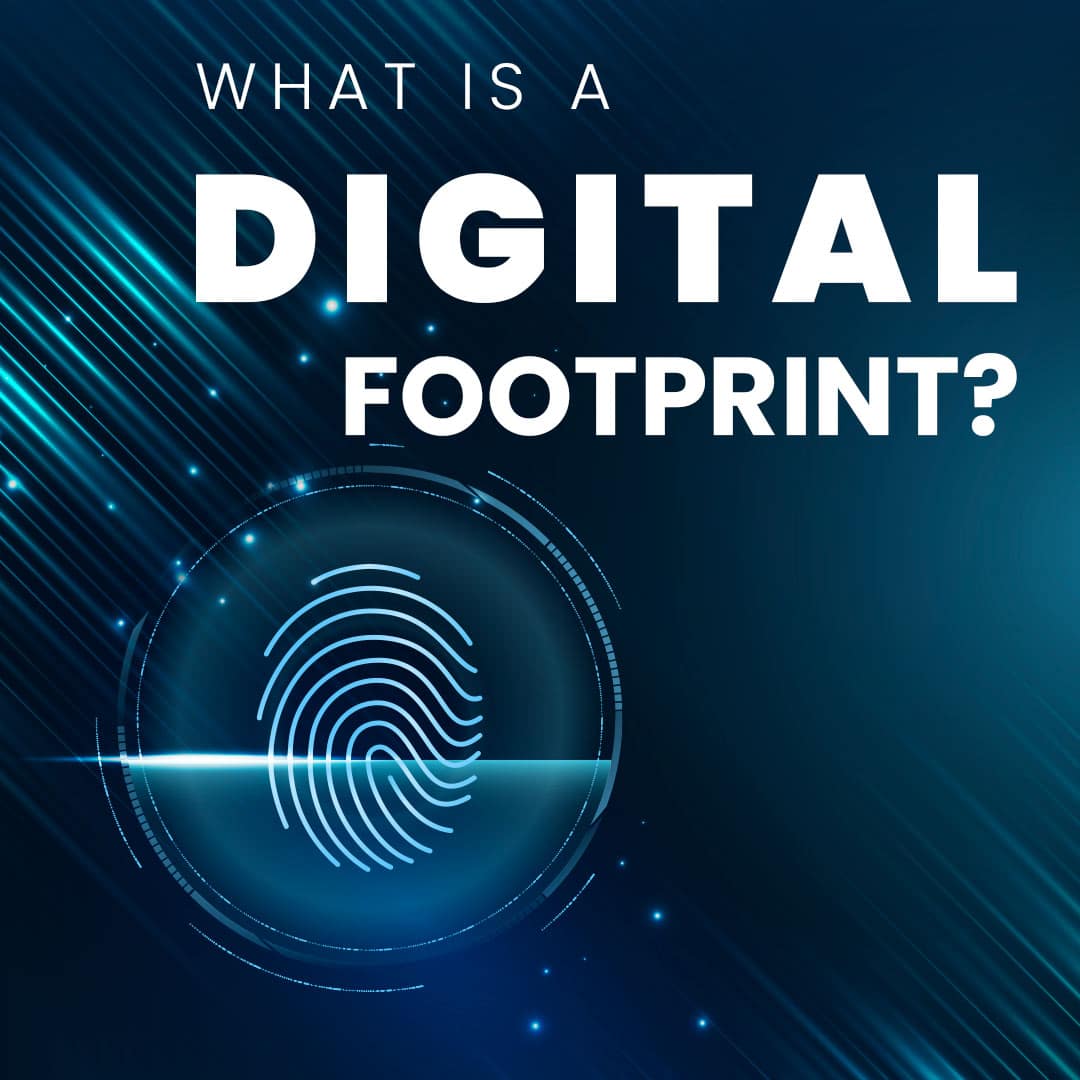Almost everything you do online leaves behind a trail of your activity, called a digital footprint. Every click, comment, and Google search can follow you, indicating your online habits and allowing other people to generate information about you.
So, what exactly is a digital footprint? And why should you care about it? Keep reading to learn more about why it matters and how you can control the digital footprint you leave behind.
Understanding a Digital Footprint
A digital footprint is a trail of data you leave behind when you use the Internet. This data can include everything from the websites you visit to the comments you leave on social media to the emails you send.
While you might not think twice about it as you browse the internet, your digital footprint is actually a critical part of your online identity, and it can have personal and professional consequences.
Prospective professional employers can learn about you through your digital footprint, so it’s important to ensure a positive and accurate representation of yourself — even in the digital world.
What Are the Different Types of Digital Footprints?
There are two different types of digital footprints: active and passive. You should understand both to fully understand your online interactions.
Active
Your active digital footprint is the traces of data you leave behind intentionally based on your actions.
This can include things like:
- Social media posts: Everything you post online, whether it’s in a public forum or not, is part of your active digital footprint. This includes social media posts, tweets, Instagram photos, comments, and more.
- Emails and messages: When you send emails and participate in online forums like Reddit, you leave behind a digital footprint. This is considered active since you’re proactively posting and sending messages.
- Online transactions: Purchasing goods or services online, filling out forms, or subscribing to newsletters is also an example of your active digital footprint.
Passive
A passive digital footprint is the traces of your online activity that happen unintentionally without specific actions being taken, like:
- Browsing history: Websites you visit, links you click on, and internet searches you conduct are all part of your browsing history that’s collected and stored — often without you even knowing.
- Cookies and tracking scripts: Many websites use cookies and tracking scripts to capture your online activities and determine the type of person you are based on your internet activity. This information helps companies understand your behavior and tailor their content or advertisements to better suit your interests.
- IP addresses: Your IP address is a unique code that provides information about where you’re located geographically and can be used to track information about your internet activity.
How Are Digital Footprints Created?
Understanding how digital footprints are created can help you manage your data and ensure you’re aware of the consequences your online activity can have. With each action you take online, you can ensure you’re only leaving behind information in your digital footprint you’re comfortable with.
Social Media
Every time you log in to your social media accounts and engage with content — be it liking, commenting, or sharing — you leave a digital trace. Even your profile information, friend lists, and the pages you follow contribute to your digital footprint.
Online Searches
Search engines like Google, Bing, and Yahoo! record your search queries and clicks. This data helps them tailor search results and advertisements to your interests but also contributes to your passive digital footprint.
Website Visits
Interacting with websites — such as reading articles, watching videos, and downloading files — generates data that forms part of your digital footprint. Websites track user behavior to improve user experience and target advertising.
What Are the Impacts of a Digital Footprint?
While you might just be casually browsing the internet, there are some important consequences to keep in mind as it relates to your digital footprint.
Personal and Professional
Your digital footprint shapes your online identity and can be interpreted as your reputation. That’s why it’s important to think about how you post can be perceived from a personal and professional standpoint.
While a positive digital presence can improve your reputation, a negative footprint can have consequences. Whether it’s an employer, a school, or new friends, you should consider how your online footprint can impact your surroundings and opportunities.
Privacy
The more information you share online, the more vulnerable you are to cybersecurity risks and having your private data available online. Cybercriminals will use your digital footprint to gather information about you and then commit crimes like identity theft, fraud, or phishing attacks.
That’s why it’s crucial to think through everything you share online and the amount of private information — both intentional and unintentional — that you leave behind when you are online.
Security
While a digital footprint can be helpful when it comes to prosecuting a cybercrime, it’s also something to be mindful of in your own day-to-day actions. Digital information that’s left behind from your internet activities can also expose you and cause a security threat.
How Do I Manage My Digital Footprint?
If you’re ready to take control of your digital footprint, there are some proactive steps you can take to make sure your data is safe online and that you’re not putting yourself at risk.
Here are some ways you can manage your digital footprint:
- Privacy settings: Make sure you constantly update and check your privacy settings on social media accounts and anywhere else online. You can adjust your privacy settings, so only people who follow you can see your activity or profile information. This can also ensure your private information is protected from strangers or anyone you don’t personally approve of.
- Changing online behavior: Everything online can be traced back to your digital footprint, so it’s important to be mindful of this as you go about your online activities. Make sure you think twice before clicking on an unknown link, commenting on a post, or sharing something on your social media profiles.
- Regularly auditing your online presence: It’s a good idea to check and audit your online presence. Whether it’s Google searching your name or reviewing your account activity, this can ensure you’re aware of the information that’s publicly available and associated with your name.
- Strong passwords: Using strong passwords for each of your online accounts can keep you safe and ensure your digital identity is secure. You should update your passwords every few months so you can reduce your chances of unauthorized access.
- Two-factor authentication: This will add an extra layer of security, such as text message codes or another authentication app that will make it more difficult for anyone to access your account.
- Manage cookies: Regularly clear cookies and browsing history, and use browser extensions to block trackers. Many websites use cookies to track your online behavior, which can be used to build a detailed profile of you.
While your digital footprint is an undeniable part of your online presence, with some smart behaviors and careful monitoring, you can ensure your digital footprint is secure and your personal information is protected.
Digital Footprints in the Future
As technology advances, your digital footprint will also change, and it’s important to stay ahead of emerging technologies to keep your digital identity safe. AI and blockchain can change how digital footprints are created and managed.
AI can analyze large amounts of data to figure out trends and patterns that a normal human might not realize as it relates to your individual digital footprints. While there are some great benefits, like helping businesses better understand customer behavior and preferences, it also raises concerns about data privacy and security.
Blockchain technology is a decentralized and secure way to manage digital footprints. It can improve data integrity and privacy by providing transparent records, allowing individuals to have more control over their data.
The Bottom Line
While you might not think about it every day, every comment, post, email and Google search is tracked through your digital footprint, and being aware of the traces you leave behind can help you stay safe online.
At Digital Forensics, we can help you audit your digital footprint, investigate data breaches, and analyze other digital footprints. Our team is composed of forensic investigators, certified fraud examiners, former law enforcement officials, certified digital forensic examiners, data analysts, and system and network domain experts. You can trust us to investigate any data incidents or issues with your digital footprint.
Contact us today to get started and speak to a specialist.
Sources:
Online Safety Basics: National Cybersecurity Alliance | Stay Safe Online
Manage your online reputation: Google Account Help | Google
How Websites and Apps Collect and Use Your Information | Consumer Advice






